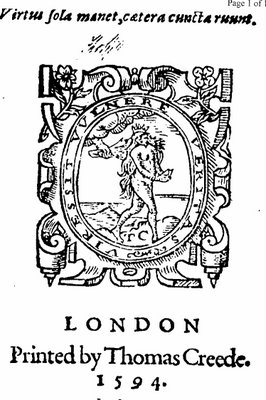
I know the world has been waiting on tenterhooks to find out the meaning of the emblem of the 16th-century printer Thomas Creede: well meet “Truth”. That’s who it is. (That’s according to Bigmore and Wyman A Bibliography of Printing, Volume I, p. 148-9.)
Creede himself wasn’t however, above the odd porkie: in 1595 he was fined and put on a £40 bond for having kept an apprentice without enfranchising him after the proper period.
Now you are going to ask why she’s naked – well beyond the obvious answer of “sales”.
Marina Warner’s brilliant Monuments and Maidens tells me:
“In general, mediaeval Christian iconography did not represent Truth naked: following rather the more traditional imagery of the virtues, it depicted her as a clothed virgin.
In language, however, the association of truth with disclosure is very ancient indeed, and this metaphor, when applied anthropomorphically, was translated into nakedness. .. Horace speaks of nuda veritas and Petronius of nuda virtus… truth possesses an eschatological body, transfigured and innocent, “sprung out of the earth”, she is also primordial and aboriginal, like nature …”
Warner traces her through Alberti, Botticelli’s The Calumny of Apelles and to the pageant at which Elizabeth was welcomed to London in 1559, although then Truth wore white silk. (pp. 317-9)
Regular readers won’t be surprised to know I now have a new question: can anyone suggest a good/standard text for the history of Oxford and Cambridge Universities, covering particularly the late 16th century? (This is traditionally where I say you are all scholars and gentlepersons and worth more money…)

 About
About
3 Comments